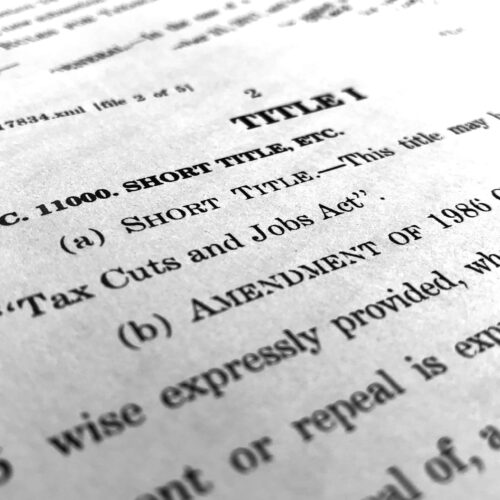Introduction
On Nov. 9, 2017, the U.S. Senate unveiled its version of the massive tax cut bill, the very same day the House moved its bill out of committee and on to the schedule for a floor vote. Republicans were moving swiftly.
The meaning of that pace wasn’t lost on a politically savvy group of tax law professors at the New York University School of Law. They realized immediately that the legislative road to be traveled by this tax bill would be different from anything that came before — and not in a good way. Academics like themselves, they realized, not to mention the public, would not be afforded the typical hearings, comments and critiques that such complicated legislation usually receives to air out problems, mistakes and unintended consequences.
Among the group: David Kamin, who had worked on tax and budget policy for President Barack Obama’s White House before joining the NYU faculty in 2012. He sensed the Senate bill needed some aggressive vetting, and so he and his colleagues set out to do just that. Kamin called fellow tax scholars at NYU, the University of Michigan, Ohio State University and several other universities nationwide.

“I asked my colleagues to drop everything and work as hard as they could,” Kamin said.
Their goal: publish what might be the legislation’s only academic review. They hoped that members of Congress would see what they wrote, and the press would publicize it, forcing politicians to make corrections that might avoid confusion and unintended consequences down the road.
They found plenty in the bill that needed correcting — scores of vague provisions and line upon line of confusing language. But Congress was moving at warp speed, and so the professors couldn’t finish their paper before the House and Senate bills were passed and headed to conference. On Dec. 7, 2017, the scholars published online “The Games They Will Play: Tax Games, Roadblocks, and Glitches Under the 2017 Tax Legislation.”
Late or not, the paper was a hit among academic works. Within a week it was downloaded 36,000 times, picked up by the national and international press. It was, in a short week, among the most downloaded of papers published during 2017 on the Social Sciences Resource Network, an online repository for scholarly works.
The professors revised the paper after the House and Senate released their conference bill. But Congress, in a seemingly unusual hurry, rushed to pass the conference bill in the two days after the revised paper was posted on Dec. 18. There were no signs that anyone in Congress had read it.
One of the authors, NYU professor Daniel Shaviro, wrote a blog post a day before President Donald Trump signed the measure bill into law on December 22, taking Congress to task for its rapid passage of the bill. He noted that lawmakers had failed to follow proper parliamentary procedure to name the bill, which everyone called the Tax Cuts and Jobs Act. “They were in such a heedless rush that the bill ended up without a name!” Shaviro wrote. “Of course, it doesn’t deserve a name.”
The professors’ final 68-page report was a detailed and critical document. The report’s overarching message: Because the law was written in such haste, with no input from outside experts, it contained loopholes bound to invite gamesmanship and would likely generate even more debt over 10 years than the $1.5 trillion the law was designed to create.
“The tax legislation was drafted and passed quickly through a rushed process,” the authors wrote, “denying legislators and the public sufficient time to analyze the provisions of the legislation — many of which are highly complex.”
Among the highlights from the report:
- Because the corporate rate dropped from 35 percent to 21 percent, more people would likely arrange to take their income through corporations rather than as individual income, which could be taxed at a rate as high as 40 percent. Normally, a person earning money as a corporation is first taxed at the corporate rate and then taxed again when the money is distributed to them as a dividend. But the paper describes several strategies that might be used for skipping the second step. One would be to just accumulate corporate stock, not take dividends and borrow money using the stock as collateral. You might pay interest of, say, 5 percent on the borrowed money, but you would not be paying any individual income tax on it.
- The tax law allowed qualifying business owners to take a 20 percent cut off the top of the income that they “pass through” from their businesses to themselves. Pass-through entities are typically partnerships and S-corporations, and can earn millions of dollars in revenue. Fearful they were giving away too much, the bill’s authors limited the bill’s full benefits to a short list of professions, including real estate developers, retailers, and oil and mining contractors. For no stated reasons, the bill reduces pass-through benefits to doctors, lawyers, accountants, actuaries, and people engaged in athletics and the performing arts if their taxable income is more than $157,500 as individuals or twice that as a couple.
The academics say that those prohibited from using the pass-through deduction could game the law to take advantage of it, such as a dermatologist selling skin care products through a separate company and taking 20 percent off the earnings. While the IRS recently proposed rules to stop some the gaming of pass-throughs, “there is still lots of uncertainty,” Kamin said.
Gene Steuerle, coordinator of Treasury’s tax reform effort in 1984 to 1986 under President Reagan now a fellow at the Urban-Brookings Tax Policy Center and not one of the paper’s authors, called the pass-through provision the “worst part of the bill, a most convoluted and complicated” set of provisions.
- The tax law capped the amount taxpayers may deduct in state and local taxes at $10,000. The provision is the largest revenue generator, estimated to raise about $600 billion over 10 years, making it one of the biggest revenue sources designed to hold the bill’s 10-year deficit to the required $1.5 trillion. But after the law passed, several states [WG15] changed their tax laws to help taxpayers retain the deduction. One ploy was allowing taxpayers to give a portion of the state taxes they owe to a state-linked charity or to a municipal or school fund, turning their taxes into charitable deductions which could be deducted from their federal tax returns. The IRS in April proposed rules curbing such actions; several states earlier sued the federal government claiming the $10,000 limit was unconstitutional. If they lose, the states have indicated they would sue over the new rules. “The essential problems” with the SALT cap “arise from the unprincipled nature and hasty enactment of this cap,” the academics wrote.
- The 2017 tax act set out to generally lower corporate taxes, and to encourage multinational corporations to return to the U.S. profits they had been storing overseas, where tax rates were lower. But it created a morass of arcane rules that are daunting for corporations to navigate. The U.S. Chamber of Commerce sent the Treasury Department a 15-page letter in March 2018 asking for clarification of the new tax law provisions. Eight of the 15 pages described problems in the international provisions. As Treasury scrambled to write regulations to help corporations interpret the law, news broke that some countries were taxing profits that U.S. corporations tried to move back to the United States. That was discouraging repatriation, reducing the $339 billion in additional tax revenue over 10 years that Republicans counted on. Even the professors’ report did not anticipate this.
- Some parts of the law would have the opposite effect from what was intended, the professors contended. For instance, one part of the international provisions assesses zero tax on profits made overseas from “tangible assets” — those derived from factories and machinery located there. Because of that, companies will want to move their factories (and jobs) overseas to take advantage of the zero tax. “These dynamics run contrary to Congress’s pronounced policy objective of discouraging offshoring,” the paper states.
Congress was quick to correct at least one error called the Grain Glitch. In an apparent last-minute attempt to help grain cooperatives, the bill’s authors gave a 20 percent tax break to farmers on the profits they made if they sold their grain to co-ops. Independent grain wholesalers howled, saying that the tax preference for cooperatives would drive them out of business.
“This was a flat-out mistake,” said Mark Mazur, director of the Tax Policy Center and assistant secretary for tax policy at the Treasury Department during the Obama administration. The GOP-led Congress took away the preferential treatment in March 2018, but Democrats cut a deal to get more tax cuts for low-income housing.
With the tax law now one year old, Treasury and the IRS continue to furiously propose rules to interpret its provisions and provide guidance. But it will take months, even years, for these proposed rules to become final, and even then, some may be litigated. Meanwhile, as with the Grain Glitch, other big problems can only be fixed with new legislation.
If last year is any indication, such legislation will be hard to come by. Before they left for the holiday recess, House Republicans drafted a bill to fix a half-dozen problems in the law, including the taxing of benefits like parking given to employees of churches. But Democrats said they wanted to extract concessions, just as they did with the Grain-Glitch fix. The bill never came to a vote.
Now with Democrats in charge of the House, concessions may come at a high political price, such as correcting longstanding problems in the Affordable Care Act. The Tax Policy Center’s Mazur said. “If you’re a Democrat, you might say, ‘When [you agree to] do the ACA technical corrections, we’ll do that,’” he said.




Join the conversation
Show Comments